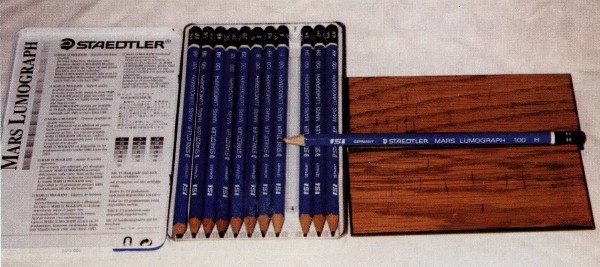
A set of graded pencils
After doing some testing on various coatings for their 'pencil hardness', I was surprised at the results I got. I thought I would share this information with those who may have their own opinions about what they consider to be hard and durable coatings. I would like you to know right from the beginning that the pencil hardness test is only one of many tests used to evaluate coatings. There is obviously more than the hardness of any coating to be considered, so do not judge a finish entirely on the basis of this test.
The test is very simple to do, will give uniform results, and is dependable because the pencils are graded. The grade of the pencil is determined by the amount of baked graphite and clay in its composition.
Grading pencils come in an assortment of both hard and soft, and can be found in most art or office supply stores. The set I have consists of twelve pencils, ranging in hardness from 4H to 6B. The 'H' stands for hardness, the 'B' stands for blackness, and HB is for hard and black pencils. The hardest is a 9H, followed by 8H, 7H, 6H, 5H, 4H, 3H, 2H, and H. F is the middle of the hardness scale; then comes HB, B, 2B, 3B, 4B, 5B, 6B, 7B, 8B, and 9B, which is the softest. Another grading method uses numbers; the equivalents would be #1=B, #2=HB, #2-1/2=F, #3=H, and #4=2H. The most commonly used writing pencil is the #2 (HB grade), which is fairly soft, contains more graphite, and leaves a dark mark.
To do your own pencil hardness testing, always start with a dry, clean, well-sanded piece of wood.
| Type of coatings | Pencil Hardness |
| Catalyzed polyester | 9H |
| Catalyzed polyurethane | 9H |
| Catalyzed Modified Acrylic polyurethane | 4H |
| Catalyzed Acrylic polyurethane | 2H |
| Water-based polyurethane | 3H |
| Water-based urethane/ Isocyanate Catalyst | 2H |
| Conversion varnish | 4H |
| Low VOC Catalyzed laquer [24 hrs] | 2H |
| Low VOC laquer | 3H |
| Urethane/Nitrocellulose laquer [24 hrs} | F |
| Water reducible laquer | 2H |
| Tung oil/polyurethane wipe-on finish | 2H |
| Water-based polyurethane wipe-on finish | HB-F |
| Aerosol precat | 3B |
| Aerosol water clear acrylic | 3B |
| Aerosol clear shellac | 3B |
| Aerosol nitrocellulose/ polyurethane | HB |
| Aerosol nitrocellulose | 3B |
| Amber (orange) Shellac 1 lb. cut | 3B |
Select a pencil from your set and make a line about 1/2-inch long. If the pencil you start with scratches the surface of the coating, then go down the pencil grades until you come to the first pencil that doesn't scratch the coating. Redo the test, and if you get the same results, you have determined the 'Pencil Hardness' of the coating you are testing. It's that simple. There are some coatings so hard that the 9H pencil won't scratch them-all of these coatings get a 9H rating to designate their hardness.
Use this chart only as a guide. It is also important to understand that the degree of hardness of any generic coating may not always be the same; in other words, if one company has a polyurethane with a 3H hardness, do not assume that every other polyurethane will have a 3H hardness. They won't; they will vary from manufacturer to manufacturer, and from product to product.
As I mentioned previously, the pencil hardness test is only one of many tests that are done to evaluate a coating's performance. Other tests are abrasion, reverse impact resistance, direct impact resistance, cross-hatch adhesion, oxidation, gloss retention, UV resistance, yellowing, blistering, drying times, chemical/solvent resistance (using both the rubbing and spot/time tests), salt spray resistance, humidity resistance, acid and caustic resistance, the VOC and HAP contents, and so on.
All this information is helpful in choosing or evaluating a finish. But regardless of a finish's rating, the best advice is always: 'handle with care'.
Mac Simmons is a 40-year veteran of the furniture, refinishing, and restoration trades, and the author of the Refinishing Commandments. He lives in Massapequa, New York.